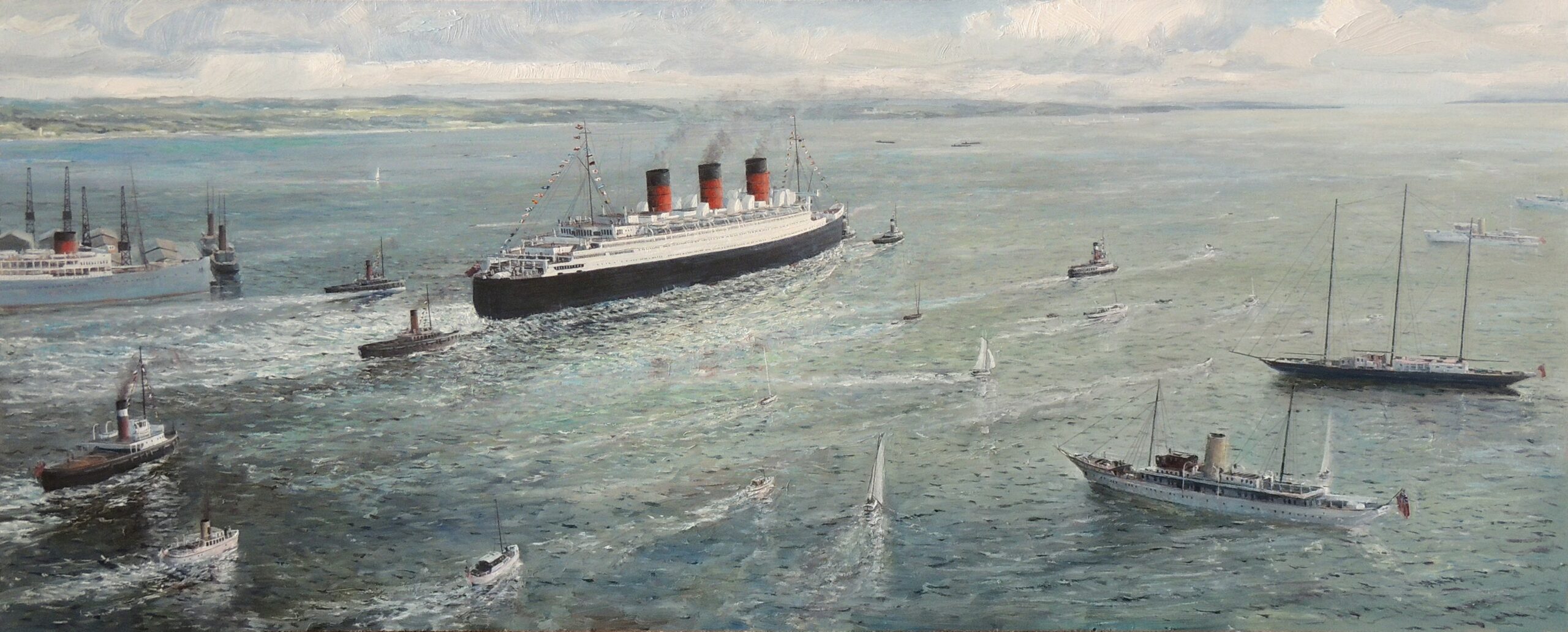Today the Queen Mary lies dormant in a dock in Long Beach California, but from 1936 to 1967 this British ocean liner was among the premiere ways to travel. In Gregory Smith’s Queen Mary’s Maiden Voyage: Departing Southampton, we see the Queen Mary in all her glory. As a newly commissioned ship, she is the latest and most technologically advanced vessel of her time. Although the ship is a tourist attraction today, we see the serenity and hope for the future as it departs from Southampton in this depiction.
Gregory Smith captures a lot in one painting. As The Queen Mary drifts out to see, tugboats and fishing vessels usher her along. It must have been a masterful scene in 1936 when ocean travel was merely a dream for many people. Remember, at this point in history, there were no coastal regions lined with yachts and cruise ships. Industries were just beginning to take shape and technology, especially marine technology, was still largely in its infancy.
Although people are not physically seen in the painting, we can imagine the wonder and amazement filling their spirit as they watch this large vessel effortlessly move across the water. It must have been amazing to witness such a historical event. It makes us think about those still remaining on shore and watching the event take place and the people onboard in their best attire excited about their oceanic journey.
Another attribute to this particular scene is the sound of it. Certain paintings have their own sound element. This notation on art is rare, but when viewing Queen Mary’s Maiden Voyage: Departing Southampton, you can almost hear the sound of the ship’s horn as it departs the bay warning boats of its enormous presence. Gregory Smith has done a masterful job of presenting us with a piece of history from a bygone era in vivid detailed colour that is not generally awarded to images of that time period. We are blessed to have such a historically important piece depicted in such a stunning manner.
What made you want to paint this particular image?
I live in Southampton, so I have a local connection to the scene, and was surprised to find relatively little record of this event.
A few years ago I thought it would be interesting to paint a series of Queen Mary pictures; I’d created a painting of the ship approaching Southampton in 2020 (‘Queen Mary’s First Approach to Southampton, 1936‘, which you can see on my Art2Arts portfolio), and I exhibited that with the Royal Society of Marine Artists, where as part of my submission it was awarded the RSMA New Generation Award.
This painting was the natural sequel to that one.
Did you visit the Queen Mary to get a better perspective of the ship?
No, I wasn’t able to travel that far, but fortunately there was plenty of material available for my reconstruction of the ship, and I had a fair amount of research done already as part of my preparation for the earlier painting.
This was more a case of understanding the viewpoint to take, and what else would have been present at the departure.
What draws you to painting historic vessels in your work?
Partly it’s the influence of painters like Geoff Hunt, and other painters in the RSMA, whom I’ve been fortunate to have exhibited alongside as part of three recent annual exhibitions.
But mostly I think it’s about the challenge of bringing these things back to life to show people what the past looked like, with both with technical accuracy and creative interest.
I’m interested in maritime subjects generally, and have also quite recently started painting them en plein air around where I live, so if you’re interested in the more modern subjects as well as seeing future historical projects.
How do you get historically accurate information for your pieces?
Any form of source available – with Queen Mary there is the real thing, of course, and a reasonable amount of accessible photography as a result.
But usually the plans are always the starting point for ships, as you can draw a perspective representation from those directly with confidence that the result will be accurate.
After that: anything from models of the vessel to documentation about certain details and when they might have been fitted.
Contemporary photography is invaluable, but can be challenging to interpret with the limitations of the cameras of the time. I also don’t like the idea of relying on photography; I don’t see any point in recreating an existing image, and like to search for an interesting angle that hasn’t been seen before.
What is your ultimate favourite historic vessel and why does it mean so much to you?
A tricky question! There could be a few answers on a few different grounds, but for now I’ll go with an obscure little vessel – The Calshot Spit lightship.
It’s a piece of local history – a crewed floating lighthouse that warned ships of a spit of land at the end of Southampton Water. It was later replaced by a buoy and left half-abandoned at a dockside here, before very recently being moved to a local museum.
I painted it for the RSMA exhibition last year, where that painting sold, so with that added in I think Calshot Spit is as good a contender as any to be my favourite vessel.
View this amazing piece in all it’s glory: View Artwork


